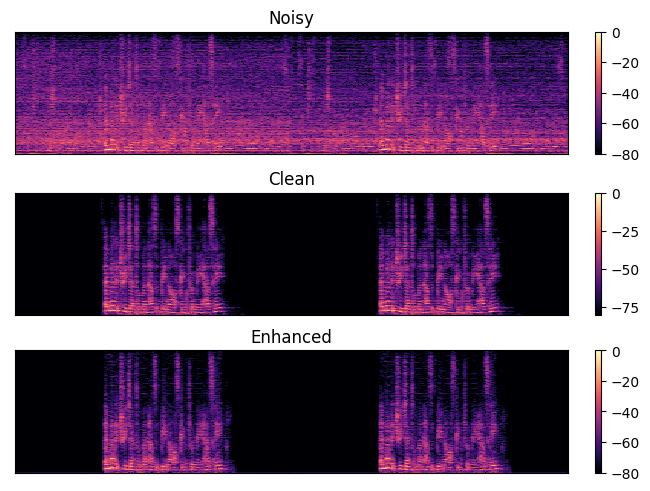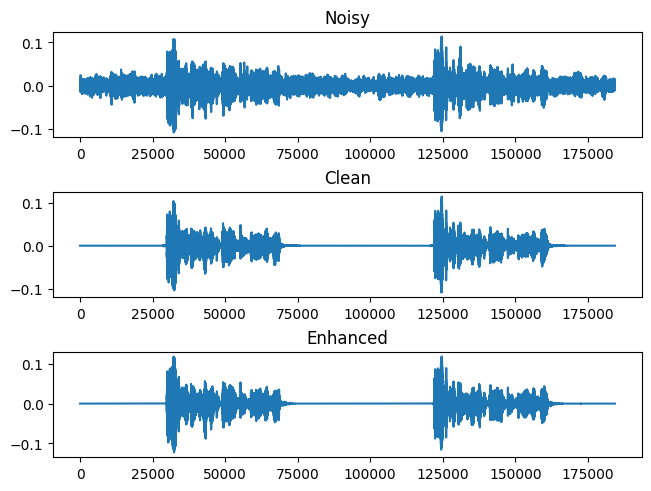@author daniel.oh
@data 2023.03.30
This repository is for the 2023 ICASSP Clarity Challenge for Speech enhancement with hearing aid. It used two addtional repository, which are ML model for speech enhancment and Hearing aid modules. The main model is Conv-Tasnet using Permutation Invariant Training(PIT).
Before starting, it clone a git from https://github.com/ooshyun/Speech-Enhancement-Pytorch as "mllib" folder, and added ./recipes/icassp_2023/MLbaseline.
- Clarity Challenge 2023 Main page : https://claritychallenge.org/docs/icassp2023/icassp2023_intro
- Clarity Challenge 2023 Github : https://github.com/claritychallenge/clarity/
-
clarity/receipes/icassp_2023/baseline/enhance.py: It processes from each mixture sound depending on scene name to denoised and save as wav file. From this file, participants should implement their own enhanced mechnism.
-
clarity/receipes/icassp_2023/baseline/evaluate.py: It processes from each enhanced sound to amplify and compress, and score the sound using clean sound and "anechoic"(deverbersed) sound using haspi/hasqi metric. These score saved as .csv files.
-
clarity/receipes/icassp_2023/baseline/report.py: It load .csv file and avergage haspi/hasqi scores
-
SOXXXX: Scene name
- XXX_mix_XXX.wav : several person and target person
- XXX_interferer_XXX.wav: several person
- XXX_target_XXX.wav: clean sound for target
- XXX_anechoic_XXX.wav: sounds free from echo for target
-
L0XXXX: Listeners ID, which can load hearing loss
- Dataset
- Dataloader
- trainer
- model
- evalutation
- submission file
- Used library: julius,librosa, torchaudio
-
The model is Conv-Tasnet using Permutation Invariant Training(PIT) with Pytorch.
-
DCUnet, 2018:
-
DeepComplexCRN: https://github.com/huyanxin/DeepComplexCRN
-
Wave-U-Net:
-
Conv-tasnet
-
Demucs(Implemented in Pytorch)
- drums, bass, vocal, others
- denoiser: https://github.com/facebookresearch/denoiser
- demucs: https://github.com/facebookresearch/demucs
- Demucs v2
- Demucs v3
- Transformer
-
Conformer GAN: https://github.com/ruizhecao96/CMGAN
-
Dual-signal Transfomration LSTM: https://github.com/breizhn/DTLN
-
Full subnet: https://github.com/haoxiangsnr/FullSubNet
-
Previous MS Noise Suppression, open-source
If want to test 3 models, then it should change manully model parameter in ./mllib/src/model/conv_tasnet.py
-
Reference. https://github.com/JusperLee/Conv-TasNet/tree/9eac70d28a5dba61172ad39dd9fb90caa0d1a45f
-
1 epoch: 316+56 step
-
randomly cropping the wavform
-
dataset channel 0, 1, 2, 3
-
skip: False
-
segment 4
-
norm z-score
-
Utterance-level Permuatation Invariant Training (uPIT)
-
Saved Model
- 20230220-100114 - N, L, B, H, P, X, R, Norm, Casual, batch - 128, 40, 128, 256, 3, 7, 2, gLN, X, 16 - 20230221-231507 - N, L, B, H, P, X, R, Norm, Casual, batch - 512, 32 128, 512 3 8 3 gLN X 4 - 20230223-140053 - N, L, B, H, P, X, R, Norm, Casual, batch - 512, 40 128, 512 3 8 4 gLN X 4
The details of results can show in ./tensorboard, and it prepared to inference noisy sound file to denoise using inference.ipynb and conv-tasnet in result/model.
-
(20230221-231507) Wavform, S03488_target_CH1
-
(20230221-231507) Spectrograms, S03488_target_CH1
-
(20230221-231507) Audio, S03488_target_CH1
- NAL-R
- Each freqeuncy gain, bias, Each freqeuncy/HL bias, hl*0.31 gain
- interpolate 1D
- att 5, release 20, attenuate 0.0001, threshold 1, makeup gain 1,
- Compression depending on the rms
if rms_i > self.threshold: temp_comp = (rms_i * self.attenuation) + ( (1 - self.attenuation) * self.threshold ) curr_comp = (curr_comp * (1 - self.attack)) + (temp_comp * self.attack) else: curr_comp = (1 * self.release) + curr_comp * (1 - self.release) ... signal * np.array(comp_ratios) * self.makeup_gain
- x: original, y: amplified
-
Ear Model
- itype = 0, channel = 32
- Cochlear model parameters
- itype = 0, HL = 0 else HL = HL
- resample 24kHz(Resamp24kHz, diff length of result with resampy resampe)
- align processed and original
- [HASQI] amplified using NALR
- Cochlear model for middle ear(LP 5000Hz, HP 350Hz)
- Auditory filter bank for each channel
- Gamma Tone band (middle ear, Max HL BW)
- Cochlear compression
-
Envelop filter
-
Ceptral Coeffcient
-
Modulate Filter
-
Correlation
-
Neural Feedforward
- Ear Model: itype = 1(NALR gain apply)
- Smoothing
- Mel Correlation(Ceptral correlation)
- spectral differiate(log-term spectra)
- Temporal Correlation
- Segment cross-covariance
- nonlinear/linear performance
- nonlinear*linear -> max of middle of nonlinear * middle of linear
*The details for reference is on the each python files.

